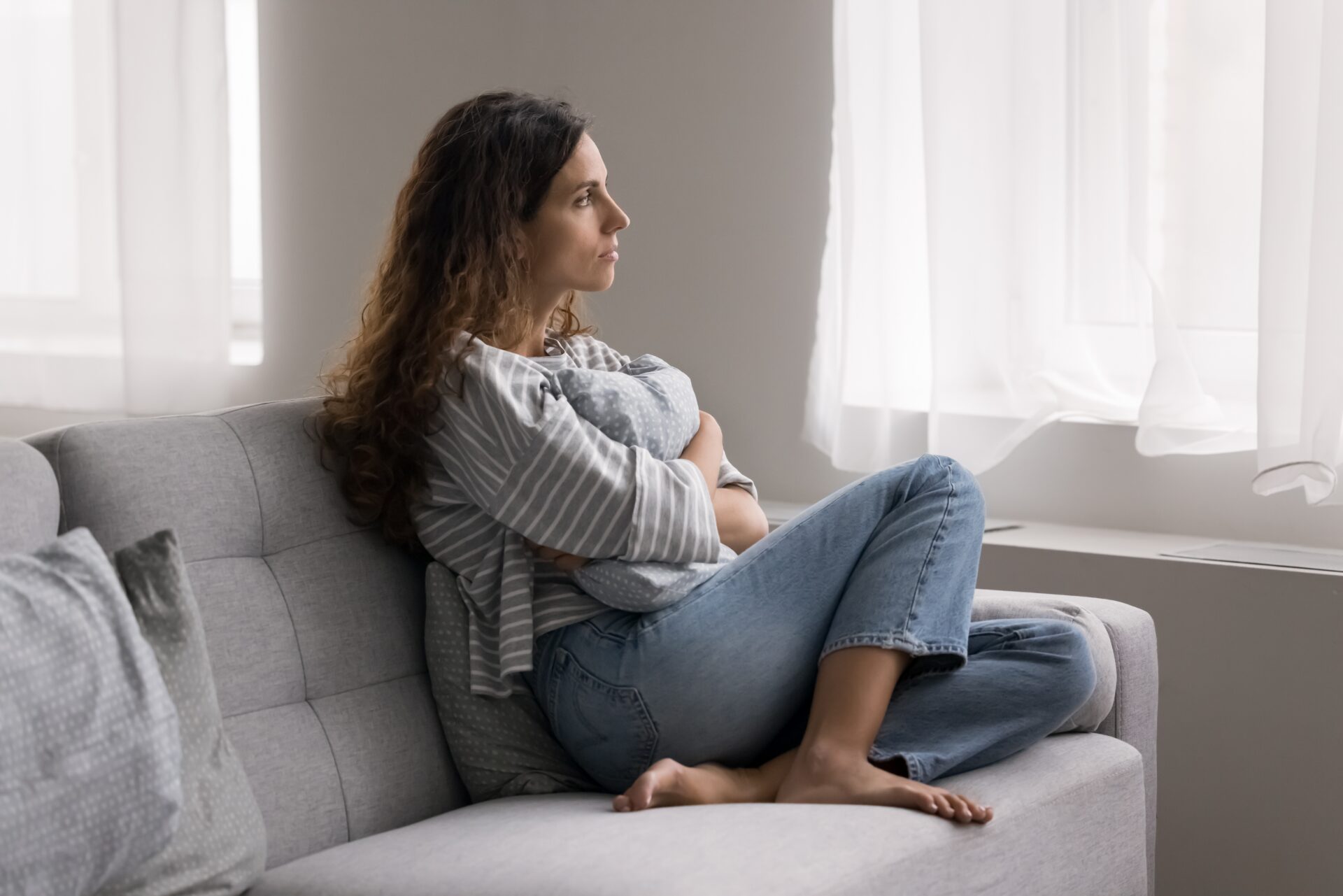Agoraphobia vs. Anxiety Disorders
At its core, agoraphobia is an anxiety disorder that can greatly impact a person’s life. It involves an intense fear of being in situations where escape might feel difficult or help might not be readily available.
This fear can lead to avoiding places or situations, which is a very isolating way to experience life. Recognizing how agoraphobia and anxiety interact can provide insight into the struggles many people encounter on their journey to better mental health.

What are Anxiety Disorders?
Anxiety disorders represent a group of mental health conditions characterized by excessive fear and worry. Just as there are various types of depression, anxiety disorders encompass a range of experiences and symptoms that can differ from person to person.
According to insights from the National Institute of Mental Health (NIMH), anxiety disorders are among the most common mental health issues in the United States, affecting approximately 19.1% of adults each year [1]. This prevalence illustrates the significant impact these disorders have on people and society as a whole.
To understand the scope of these disorders, it’s helpful to look at their most common symptoms [2]:
- Difficulty controlling worry
- Nervousness, restlessness, tension
- Avoidance of situations that trigger anxiety
- Feelings of impending doom, panic, or danger
- Increased heart rate, rapid breathing, sweating, trembling
- Weakness, fatigue, GI issues
- Difficulty concentrating, sleep disturbances
Anxiety disorders aren’t just about situational worry or stress that comes and goes. Rather, the associated worry and fear remain relatively constant, don’t go away independently, and may worsen over time. Anxiety disorders can significantly impact daily functioning.
Agoraphobia and Its Symptoms
Understanding agoraphobia and its link to anxiety requires a solid exploration of its symptoms. Marked by a fear of situations or places that could trigger feelings of panic, helplessness, or embarrassment, agoraphobia affects approximately 1.7% of adults and adolescents [3].
This anxiety often arises from concerns that experiencing a panic attack or other distressing symptoms may make it challenging or impossible to leave the situation. This fear can be overwhelming, leading to significant distress or impairment in various aspects of life, including social and occupational functioning [3].
Common symptoms of agoraphobia include [4]:
- Fear of crowded places: Many people feel anxious in crowded areas, fearing they may not be able to leave quickly if they begin to panic.
- Avoidance of certain situations: People with agoraphobia might avoid situations such as public transportation, shopping malls, or open spaces to prevent triggering anxiety.
- Panic attacks: Some people experience panic attacks when faced with situations they fear, leading to physical symptoms like heart palpitations, sweating, and shortness of breath.
- Feeling trapped: People can experience an overwhelming sense of being trapped in certain environments, which can exacerbate anxiety levels.
- Dependency on safe spaces: People often create safe spaces, such as their home. Leaving these spaces can provoke significant anxiety.
Symptoms can vary in severity, and approximately 40.6% of those affected report serious impairment, while 30.7% experience moderate impairment, and 28.7% exhibit mild symptoms [5].
Types of Anxiety Disorders
Agoraphobia is one of several types of anxiety disorders, each of which presents its unique challenges and symptoms. Other types of anxiety disorders include [6]:
- Generalized Anxiety Disorder (GAD): GAD involves persistent and excessive worry about various aspects of life, including work, health, and social interactions. Those with GAD often find it difficult to control their anxiety, leading to significant distress.
- Panic disorder: Characterized by recurrent panic attacks, this disorder causes sudden feelings of intense fear or discomfort. During an attack, people may experience physical symptoms such as heart palpitations, shortness of breath, and dizziness.
- Selective mutism: Selective mutism affects children, making them unable to speak in certain social situations, such as at school, despite being able to communicate at home or with close family. While some children may “grow out of it” and improve over time, others may require long-term support to overcome the associated social and academic challenges.
- Social Anxiety Disorder (SAD): This condition centers around an intense fear of social situations, particularly those involving interaction with others. People may fear being judged or embarrassed, leading them to avoid social gatherings altogether.
- Specific phobias: Various phobias involve intense fear of a particular object or situation, such as heights, spiders, or flying. The fear is often disproportionate to the actual threat.
Recognizing the different types of anxiety disorders is vital for tailoring effective treatment strategies and ensuring people receive the support they need to manage their mental health.
Agoraphobia vs. General Anxiety
While agoraphobia and GAD are both classified as anxiety disorders in the Diagnostic and Statistical Manual of Mental Disorders, Fifth Edition (DSM-5-TR), they are diagnosed based on different patterns of fear and worry. GAD involves excessive, uncontrollable worry about a wide range of everyday issues, such as work, health, or relationships.
These worries occur more days than not for at least six months. Additionally, GAD is marked by symptoms like restlessness, fatigue, difficulty concentrating, irritability, muscle tension, and sleep disturbance [3].
Agoraphobia, on the other hand, is diagnosed when someone experiences intense fear or anxiety specifically tied to situations where escape might be difficult or help unavailable.
Many people begin to avoid these situations entirely, endure them with great distress, or feel safer only when accompanied by someone they trust. To achieve an agoraphobia diagnosis, these fears must be consistent for six months or more and cause significant impairment [3].
The key difference between agoraphobia and GAD lies in the scope and trigger of the anxiety. GAD casts a wide net across many areas of life, while agoraphobia is more situationally focused. Understanding these distinctions ensures accurate diagnosis and helps tailor the most effective treatment approach for each person.
Causes and Risk Factors of Agoraphobia
The exact cause of anxiety disorders such as agoraphobia remains unclear. However, traumatic life experiences as well as genetics can play a significant role in agoraphobia [2]. Agoraphobia heritability is a remarkable 61%, meaning the risk of developing agoraphobia is highly influenced by genetics [3].
In addition, the following situational triggers are risk factors for developing an anxiety disorder like agoraphobia [2]:
- Trauma: Experiencing a traumatic event has been linked to anxiety disorders. In particular, children who witness or experience trauma are at higher risk of developing an anxiety disorder during their lifetime.
- Illness-related stress: Serious illnesses and chronic conditions can lead to significant worry and stress, which in turn can be associated with the development of an anxiety disorder.
- Co-occurring disorders: Mental health disorders can influence and sometimes exacerbate one another, so they often co-occur. For example, to reduce symptoms of depression, a person might start misusing substances.
- Cumulative stress: A buildup of ongoing life stressors, such as workplace tension or family conflict, can also raise the risk.
- Personality: Certain personality types are more prone to anxiety than others.
- Drugs or alcohol misuse: Substance use, whether as a coping mechanism or due to other challenges, can sometimes worsen anxiety symptoms or increase vulnerability.
Risk factors provide valuable insight into why some people develop agoraphobia and others don’t. However, with the right support, many of these factors can be managed effectively to improve overall well-being.
Treatment for Anxiety and Agoraphobia
Anxiety disorders such as agoraphobia are highly treatable with the right combination of therapies, medical interventions, and lifestyle adjustments. The goal of treatment is to reduce symptoms, improve daily functioning, and help people regain confidence in facing situations they may have been avoiding.
Common treatment options for agoraphobia include [7][8]:
- Therapies: Cognitive behavioral therapy (CBT) and exposure therapy can help people confront their fears and change negative thought patterns.
- Medications: Medications for agoraphobia treatment often include selective serotonin reuptake inhibitors (SSRIs), which are prescribed as a first-line treatment for anxiety, as well as benzodiazepines, which may be used for short-term relief.
- Lifestyle changes and self-help strategies: Regular exercise, mindfulness practices, and building support networks can significantly reduce anxiety. Limiting stimulants like caffeine and alcohol can also help minimize symptoms.
Agoraphobia and mental health treatment isn’t a one-size-fits-all solution. People and their mental health specialists typically mix and match various treatment options to best suit the needs and wants of each person. Combining therapy, medication, and lifestyle changes often yields the best results.
Strength Through Understanding
Agoraphobia is more than a fear of public places; it’s a complex anxiety disorder that can impact daily life. Understanding its connection to anxiety, recognizing the symptoms, and identifying potential risk factors are essential steps toward managing the condition. With proper awareness, people can better navigate the challenges that agoraphobia presents.
While the journey may sometimes feel overwhelming, it’s important to remember that effective mental health treatment is available. Therapy, medication, and lifestyle changes can make a significant difference, helping people regain confidence and reclaim parts of life they once avoided. With support and the right tools, recovery and healing is both possible and within reach.
- National Institute of Mental Health. (n.d.). Any anxiety disorder. National Institute of Mental Health. https://www.nimh.nih.gov/health/statistics/any-anxiety-disorder. Accessed May 20 2025.
- Mayo Clinic. (2018, May 4). Anxiety disorders. Mayo Clinic. https://www.mayoclinic.org/diseases-conditions/anxiety/symptoms-causes/syc-203509. Accessed May 20 2025.
- American Psychiatric Association. (2022). Diagnostic and statistical manual of mental disorders (5th ed. text rev.). https://www.psychiatry.org/psychiatrists/practice/dsm. Accessed May 20 2025.
- Mayo Clinic. (2023, January 7). Agoraphobia: Symptoms and causes. Mayo Clinic. https://www.mayoclinic.org/diseases-conditions/agoraphobia/symptoms-causes/syc-20355987. Accessed May 20 2025.
- National Institute of Mental Health. (n.d.). Agoraphobia. National Institute of Mental Health. https://www.nimh.nih.gov/health/statistics/agoraphobia. Accessed May 20 2025.
- American Psychiatric Association. (2023, June). What are anxiety disorders? American Psychiatric Association. https://www.psychiatry.org/patients-families/anxiety-disorders/what-are-anxiety-disorder. Accessed May 20 2025.
- Barnhill, J.W., (2023, August). Agoraphobia. Merck Manual Professional Version. https://www.merckmanuals.com/professional/psychiatric-disorders/anxiety-and-stressor-related-disorders/agoraphobia#Symptoms-and-Signs_v39262774. Accessed May 20 2025.
- Mayo Clinic. (2023, January 7). Agoraphobia: Diagnosis and treatment. Mayo Clinic. https://www.mayoclinic.org/diseases-conditions/agoraphobia/diagnosis-treatment/drc-20355993. Accessed May 20 2025.
The Clinical Affairs Team at MentalHealth.com is a dedicated group of medical professionals with diverse and extensive clinical experience. They actively contribute to the development of content, products, and services, and meticulously review all medical material before publication to ensure accuracy and alignment with current research and conversations in mental health. For more information, please visit the Editorial Policy.
We are a health technology company that guides people toward self-understanding and connection. The platform provides reliable resources, accessible services, and nurturing communities. Its purpose is to educate, support, and empower people in their pursuit of well-being.
Linda Armstrong is an award-winning writer and editor with over 20 years of experience across print and digital media.
Holly Schiff, Psy.D., is a licensed clinical psychologist specializing in the treatment of children, young adults, and their families.
The Clinical Affairs Team at MentalHealth.com is a dedicated group of medical professionals with diverse and extensive clinical experience. They actively contribute to the development of content, products, and services, and meticulously review all medical material before publication to ensure accuracy and alignment with current research and conversations in mental health. For more information, please visit the Editorial Policy.
We are a health technology company that guides people toward self-understanding and connection. The platform provides reliable resources, accessible services, and nurturing communities. Its purpose is to educate, support, and empower people in their pursuit of well-being.


